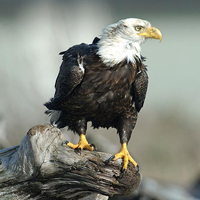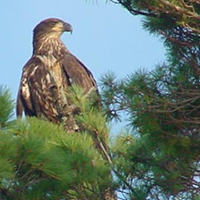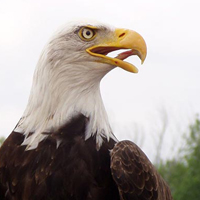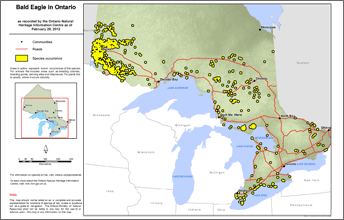Bald eagle
Scientific name: Haliaeetus leucocephalus




Cover photos credit: iStockPhoto.com (left), Bill Dalton (middle-left), David Gibson (middle-right), and John Stephens (right)
Status
Special Concern
“Special Concern” means the species lives in the wild in Ontario, is not endangered or threatened, but may become threatened or endangered due to a combination of biological characteristics and identified threats.
Date added to the Species at Risk in Ontario List
The Bald Eagle was already assessed as a species of special concern when the Endangered Species Act took effect in 2008.
What it looks like
The Bald Eagle is a well-known bird of prey with a bright white head, neck and tail, and a dark brown body. Its massive beak is bright yellow, as are its powerful legs. Adults have piercing very pale eyes. Young eagles are mostly brown, variably speckled with white. Bald Eagles have a wingspan of just over two metres. They soar on flattened wings and in silhouette show as much head and neck in front of the wing as there is tail projecting behind.
Where it lives
Bald Eagles nest in a variety of habitats and forest types, almost always near a major lake or river where they do most of their hunting. While fish are their main source of food, Bald Eagles can easily catch prey up to the size of ducks, and frequently feed on dead animals, including White-tailed Deer. They usually nest in large trees such as pine and poplar. During the winter, Bald Eagles sometimes congregate near open water such as the St. Lawrence River, or in places with a high deer population where carcasses might be found.
Where it’s been found in Ontario
Bald Eagles are widely distributed throughout North America. In Ontario, they nest throughout the north, with the highest density in the northwest near Lake of the Woods. Historically they were also relatively common in southern Ontario, especially along the shore of Lake Erie, but this population was all but wiped out 50 years ago. After an intensive re-introduction program and environmental clean-up efforts, the species has rebounded and can once again be seen in much of its former southern Ontario range.
View a Larger version of this map (PDF)
What threatens it
Historically Bald Eagles were shot as pests or trophies, and many shoreline areas where they bred were developed for housing or industry. Their largest decline came with the introduction of pesticides such as DDT that resulted in thin egg shells that broke as the adults tended to them. Although most of these threats have been reduced or eliminated, current Bald Eagle populations are impacted by the continued development of shoreline habitat and pollution.
Action we are taking
Special concern species do not receive species or habitat protection.
Management plan
A management plan advises the ministry on ways to ensure healthy numbers of the species return to Ontario.
Read the management plan (September 10, 2014).
Government response statement
A government response statement outlines the actions the government intends to take or support to help recover the species.
Read the government response statement (June 10, 2015).
What you can do
Report a sighting
- Report a sighting of an endangered animal or plant to the Natural Heritage Information Centre. Photographs with specific locations or mapping coordinates are always helpful.
Volunteer
- Volunteer with your local nature club or provincial park to participate in surveys or stewardship work focused on species at risk.
Be a good steward
- Private land owners have a very important role to play in species recovery. If you find a Bald Eagle nesting on your land, you may be eligible for stewardship programs that support the protection and recovery of species at risk and their habitats.
Report illegal activity
- Report any illegal activity related to plants and wildlife to 1-877-TIPS-MNR (847-7667).
Quick facts
- Both Bald Eagle parents share the duty of incubating eggs and looking after their young.
- Bald eagles were once a common sight in the skies of North America but by the 1950’s the population began to drastically decline because of the accumulation of DDT and other chemicals in their food chain. Use of these chemicals was restricted in the early 1970’s and eagle populations have started to rebound.
- The raspy scream of the Bald Eagle that is often heard on movies and TV programs is, in fact, the call of a Red-tailed Hawk. The Bald Eagle actually gives a sort of watery, gurgling trill that doesn’t sound like it suits the bird.
- Nesting begins up to three months earlier in the southern portion of their range compared to pairs that settle in the north.
